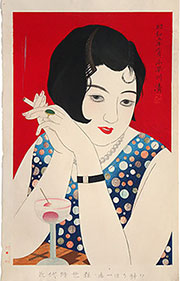Background
 Paul Binnie (born May 27, 1967) is a Scottish artist working in the Japanese woodblock print tradition. Binnie studied art history at Edinburgh University and painting and etching at Edinburgh College of Art from 1985 to 1990. After taking his Master's degree (honors) in 1990, he moved to Paris until a fascination with Japanese ukiyo-e prints beckoned him to Japan in 1993. There he studied woodblock printmaking as an apprentice to Seki Kenji, master printer for the Doi publishing house. While in Japan, Binnie began experimenting with kappazuri (stencil printing), initially with depictions of tattooed figures, followed by kabuki actors. By late 1995, Binnie left Seki's studio to concentrate on his own work, primarily focusing on actor prints, an interest that was only enhanced by his appreciation of early 20th-century shin-hanga (new print: 新版画) artists such as Natori Shunsen and Masamitsu Ota. Around that time, Binnie also began to collect landscape prints by artists such as Hasui Kawase and Hiroshi Yoshida. In 1998, Binnie relocated to London and set up his own studio, where he expanded his subjects to include cloud studies, landscapes, and bijinga (pictures of beautiful women: 美人画). In 2004, Binnie returned to depicting tattooed figures, both male and female, in the series, "A Hundred Shades of Ink of Edo" in which he applied designs from ukiyo-e artists such as Katsushika Hokusai andUtagawa Hiroshige to contemporary nude figures. Soon after completion of the tenth print in 2015, the Metropolitan Museum of Art in New York purchased the complete series for its collection. Binnie continues his work on bijinga with the series Hyakunen no hana (Flowers of a hundred years: 百年の華), which he began in 2012. This series of ten prints incorporates historical references and explores the changing roles, political and social situations, and lifestyles of women in Japan in the 20th century, decade by decade.
Paul Binnie (born May 27, 1967) is a Scottish artist working in the Japanese woodblock print tradition. Binnie studied art history at Edinburgh University and painting and etching at Edinburgh College of Art from 1985 to 1990. After taking his Master's degree (honors) in 1990, he moved to Paris until a fascination with Japanese ukiyo-e prints beckoned him to Japan in 1993. There he studied woodblock printmaking as an apprentice to Seki Kenji, master printer for the Doi publishing house. While in Japan, Binnie began experimenting with kappazuri (stencil printing), initially with depictions of tattooed figures, followed by kabuki actors. By late 1995, Binnie left Seki's studio to concentrate on his own work, primarily focusing on actor prints, an interest that was only enhanced by his appreciation of early 20th-century shin-hanga (new print: 新版画) artists such as Natori Shunsen and Masamitsu Ota. Around that time, Binnie also began to collect landscape prints by artists such as Hasui Kawase and Hiroshi Yoshida. In 1998, Binnie relocated to London and set up his own studio, where he expanded his subjects to include cloud studies, landscapes, and bijinga (pictures of beautiful women: 美人画). In 2004, Binnie returned to depicting tattooed figures, both male and female, in the series, "A Hundred Shades of Ink of Edo" in which he applied designs from ukiyo-e artists such as Katsushika Hokusai andUtagawa Hiroshige to contemporary nude figures. Soon after completion of the tenth print in 2015, the Metropolitan Museum of Art in New York purchased the complete series for its collection. Binnie continues his work on bijinga with the series Hyakunen no hana (Flowers of a hundred years: 百年の華), which he began in 2012. This series of ten prints incorporates historical references and explores the changing roles, political and social situations, and lifestyles of women in Japan in the 20th century, decade by decade.
Design
This complex design uses 47 printings (keyblock plus color blocks) and includes embossing, silver metallic pigment, and bands of 23-carat gold leaf on the stems of the glasses.
Paul Binnie's subject of a modern girl with a cocktail set against a deep red ground is a deliberate reference to a well-known shin hanga print from 1930 titled "Styles of contemporary make-up: no. 1, Tipsy" (Kindai jise sho no uchi: Ichi, Horoyoi) by Kobayakawa Kiyoshi (1896-1948). Kiyoshi's moga (modan garu or modern girl, モダンガル; see detail at right) is assertively alluring. Her demeanor and direct gaze suggest she is inebriated and perhaps not a little aroused. The presumption here is that she has adopted a life of excess, taking on Western habits such as smoking and drinking cocktails. These breaches of decorum confirm that Kiyoshi's design was intended to be a rather honest and unsettling image.
Binnie felt that Kobayakawa Kiyoshi's print amounted to criticism of the moga, who were very controversial in Japan at the time. In response, Binnie created a flattering portrayal of a moga to celebrate their defiance, independence, and modernity. The refinement and exceptional technical brilliance of Binnie's print evoke the elegance of Kobayakawa Kiyoshi's achievement, but in a contemporary idiom. Sitting alone, the moga — Japan's stand-in for the American "flapper" — is dressed with the accoutrements of a typical "modern girl," with her bobbed hair, fashionable Western clothing (blind-printed and highlighted with mica) that reveals rather too much skin, and make-up accentuating sultry, smoky eyes. She must be there with a companion, as there are two glasses on the table. Unlike the earlier portrayal, Binnie's young woman seems fit, confident, and poised — and for the moment, at least, neither the Jazz-age Manhattan cocktails nor her unseen partner have loosened this moga from her moorings.
Works by Paul Binnie are held in many public institutions, including the Metropolitan Museum of Art, NY; Brooklyn Museum, NY; Minneapolis Institute of Art; Toledo Museum of Art; Rijksmuseum, Amsterdam; and the British Museum.
Our price is well below current retail for this print, which is very popular and moving inevitably toward being sold out.
References: Kendall Brown, Paul Griffith, Akama Ryo, Paul Binnie: A Dialogue with the Past (The First 100 Japanese Prints). Chicago: Art Media Resources, 2007